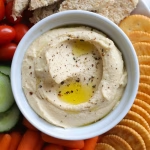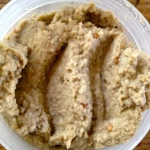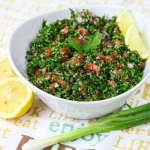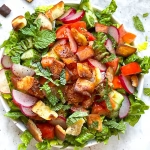Have you ever tasted the soft, aromatic, and slightly sweet goodness of Kaak Bi Haleeb (Milk Bread)? This Middle Eastern staple is beloved for its unique texture and delightful flavor, making it a popular choice in homes and bakeries alike. Originating from the rich culinary traditions of the Levant, this bread is often enjoyed during special occasions or as a comforting everyday treat. With its subtle hints of spices and the richness of milk, it’s no wonder that Kaak Bi Haleeb has found fans worldwide.
In this article, we’ll dive deep into the art of making Kaak Bi Haleeb (Milk Bread). You’ll learn about the essential ingredients, step-by-step instructions, a few pro tips, nutritional information, and frequently asked questions that surround this delicious bread. Get ready to roll up your sleeves and create a homemade experience that will fill your kitchen with warmth and enticing aromas.
Ingredients
| Ingredients | Measurements | Description |
|---|---|---|
| All-purpose flour | 4 cups | All-purpose flour forms the base of Kaak Bi Haleeb (Milk Bread) with its perfect gluten structure, ensuring a light and fluffy texture. |
| Warm milk | 2 cups | Warm milk is key to achieving the bread’s rich flavor and softness, providing moisture that elevates the overall taste. |
| Active dry yeast | 2 tablespoons | This yeast helps the dough rise, making it airy and fluffy—essential for that perfect Kaak Bi Haleeb (Milk Bread). |
| Granulated sugar | 1 tablespoon | A hint of sugar balances the flavors and feeds the yeast, contributing to the delightful crust and golden color. |
| Salt | 1 teaspoon | Salt adds depth to the flavor, ensuring the sweetness does not overpower the taste of the bread. |
| Olive oil | 2 tablespoons | Olive oil not only enriches the dough but also adds a subtle flavor, making the bread moist and tender. |
| Ground cardamom | 1 teaspoon | This spice infuses the bread with a warm, aromatic quality, characteristic of traditional recipes. |
Step-by-Step Instructions
- Step 1: Activate the Yeast – In a small bowl, combine the warm milk, granulated sugar, and active dry yeast. Let it sit for about 5-10 minutes until foamy. This step ensures your yeast is lively and ready to work its magic!
- Step 2: Prepare the Dough – In a large mixing bowl, combine the all-purpose flour, salt, and ground cardamom. Create a well in the center and pour in the activated yeast mixture along with olive oil. Mix until the dough starts to come together.
- Step 3: Knead the Dough – Transfer the dough onto a floured surface and knead for about 10 minutes until smooth and elastic. This is the workout your dough needs to develop proper gluten structure and texture.
- Step 4: Let it Rise – Place the kneaded dough in a lightly oiled bowl, cover it with a damp cloth, and let it rise in a warm spot for about 1 hour or until doubled in size.
- Step 5: Shape the Bread – Once risen, punch down the dough to release excess air. Divide it into equal portions and shape each portion into a round or oval loaf, depending on your preference.
- Step 6: Second Rise – Place the shaped loaves on a baking sheet lined with parchment paper. Cover with a cloth and let them rise for another 30 minutes.
- Step 7: Preheat and Bake – Preheat your oven to 350°F (175°C). Bake the loaves for 25-30 minutes or until golden brown. The scent of freshly baked bread will fill your kitchen, making it hard to resist!
- Step 8: Cool and Serve – Remove from the oven and let the loaves cool on a wire rack before slicing. Enjoy your warm Kaak Bi Haleeb (Milk Bread) with honey, cheese, or your favorite spread!
Pro Tips
- For an added depth of flavor, try adding a pinch of nutmeg or cinnamon to the dough mix.
- If you want extra soft bread, brush the loaves with melted butter right after baking.
- Always test the temperature of your milk before adding yeast. It should be warm, not hot, to keep the yeast active.
- Experiment with toppings like sesame seeds or poppy seeds for a decorative touch before baking.
- Don’t skip the second rise—this step is crucial for achieving a light texture in your Kaak Bi Haleeb (Milk Bread).
Nutritional Information
| Nutrient | Per Serving (1 slice) |
|---|---|
| Calories | 150 |
| Protein | 4g |
| Carbohydrates | 30g |
| Saturated Fats | 1g |
| Fiber | 1g |
| Cholesterol | 5mg |
| Sugars | 1g |
| Fats | 2g |
FAQs
What is the best way to store Kaak Bi Haleeb (Milk Bread)?
The best way to store your Kaak Bi Haleeb (Milk Bread) is to keep it in an airtight container at room temperature for up to 3 days. For longer shelf life, you can freeze it.
Can Kaak Bi Haleeb (Milk Bread) be made vegan or gluten-free?
Yes, you can substitute the milk with almond or coconut milk for a vegan version. For gluten-free, use a gluten-free flour blend, but be aware that the texture may vary.
What are the best side dishes to serve with Kaak Bi Haleeb (Milk Bread)?
Kaak Bi Haleeb pairs wonderfully with labneh, a yogurt dip, or even a savory stew. You can also enjoy it with honey or jam for breakfast!
How long does it take to prepare Kaak Bi Haleeb (Milk Bread)?
Preparation time for Kaak Bi Haleeb (Milk Bread) is about 90 minutes, including rising time. Actual hands-on time is around 30 minutes.
Can I freeze Kaak Bi Haleeb (Milk Bread) for later?
Absolutely! You can freeze the bread slices or whole loaves. Just wrap them well in plastic wrap and aluminum foil, then place them in a freezer bag.
What makes Kaak Bi Haleeb (Milk Bread) unique compared to other breads?
Kaak Bi Haleeb (Milk Bread) stands out due to its use of milk, which lends a creaminess and softness that’s hard to find in typical bread recipes.
Can I add toppings to Kaak Bi Haleeb (Milk Bread)?
Yes! Feel free to sprinkle sesame seeds or poppy seeds on top before baking for added texture and flavor.
What is the significance of Kaak Bi Haleeb (Milk Bread) in Middle Eastern culture?
This bread holds cultural significance as it’s often served during special occasions, gatherings, and celebrations, symbolizing hospitality and warmth.




